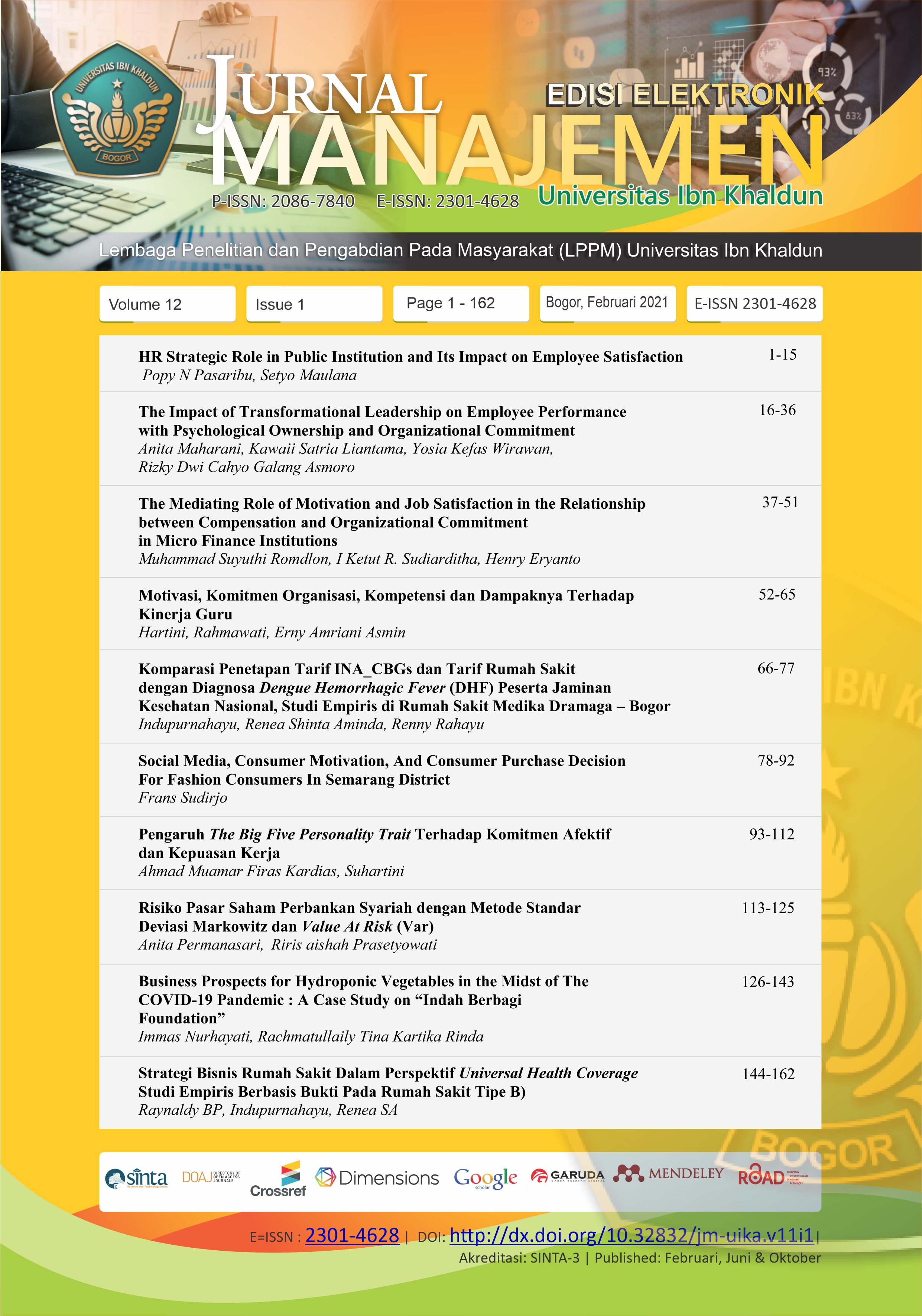Risiko Pasar Saham Perbankan Syariah dengan Metode Standar Deviasi Markowitz dan Value At Risk (Var)
DOI:
https://doi.org/10.32832/jm-uika.v12i1.4046Keywords:
Value at Risk, VAR, Historical Simulation, Analogical Simulation, Risk, Return, Standard DeviationAbstract
This study describes the measurement of market risk in Islamic banking by calculating the Markowitz standard deviation and the market risk Value at Risk (VaR). The data used in this study are Islamic bank stocks in the Indonesia Stock Exchange, namely in JII or ISSI. Data obtained from reference sources and using secondary data. The observation period carried out is for 108 days from January 2 to June 11, 2020, with a daily period. The research methodology used to measure the greatest potential risk (loss) incurred in investing in the telecommunications stock index is the Markowitz standard deviation approach and the Value at Risk (VaR) using the Historical and Modeling (Analytical) methods. The results showed that the recommendations for efficient stock selection from the three banks were BRIS banks with an E (R) of 8.5% and a risk level of 1.33%. The lowest portfolio return of -0.1109% occurs on the 60th day and the highest portfolio return of 0.0769% occurs on the 47th day. Then On the daily 95% VAR, the lowest 5% return on a daily basis for BRIS is 5% from 108 days, occurs on the 85th day of -0.248% and the highest return occurs on the 47th day of 0.1444%. At the daily 95% VAR, the lowest 5% daily return of BTPN SYARIAH is 5% from 108 days, occurs on the 67th day of -0.247% and the highest return occurs on the 47th day of 0.758%. At the daily 95%, VAR with 5% lowest daily return of PANIN SYARIAH is 5% from 108 days. It does not happen, likewise, the highest return does not occur until the 108th day (the day of this research observation). If we have PANIN SYARIAH shares of Rp. 1 billion then there is no market risk (loss rate) at 95% daily. For a 5% possibility of tomorrow's portfolio loss on BRIS shares.
References
Al Arief M Nur Rianto,Dr, Msi, dan Yuke Rahmawati, MA, 2018, Manajemen Risiko Per-bankan Syariah, CV Pustaka Setia, Bandung
Arthini, KD & Harini, 2012. Perhitungan VaR portofolio saham menggunakan data historis dan data simulasi Monte Carlo.e-Journal Matematika, Volume 1, Nomor 1 Agustus 2012.
Buchdadi, AD, 2008, penghitungan Value at Risk portofolio saham perusahaan berbasis syari-ah dengan pendekatan EWMA, Jurnal Akuntansi Keuangan
Cakir HM & Uyar M, 2013. Portofolio Risk Management with Value at Risk: A Monte-Carlo Simu-lation on ISE-100. International Research Journal of Finance and Economics.
Čorkalo, Å . 2011. Comparison Of Value At Risk Approaches On A Stock. CRORR, Vol-ume 2.
Habib Ahmed,MA,M.Econ,PHd, Dr Tariqullah Khan, 2014, Manajemen Risiko Industri Keuangan Syariah, PT Aqwam Meda Profetika, Solo
Hanafi, Maduh M. Dr,MBA, Dr Tariqullah Khan, 2014, Manajemen Risiko, UPP STIM YKPN, Yogyakarta.
Imam W, Fenny R, M. Budi P, Niken Iwani SP, 2015, Risk Management for Islamic Banks, Wiley Finance Series, Singapore.
Jurnal Akuntansi, Department Akuntansi FEUI, Jakarta.
Jogiyanto, Hartono,Akt,Mba,Phd,CMA 2014, Teori dan Praktek Portofolio dengan Excel, Salemba Empat,Jakarta.
Leony P Tupan, Tohap Manurung, Jantje D. Prag (2013), Pemilihan Portofolio Optimal Dengan Pendekatan Value At Risk (VaR), Thesis, MMUGM Yogyakarta
Sahara, Ayu Yanita. (2013). Analisis pengaruh inflasi, suku bunga BI, dan produk domestik bruto terhadap return on asset (ROA) bank syariah di Indonesia. Jurnal Ilmu Manajemen (JIM), 1(1).
Sudarsono, Heri . (2009). Dampak Krisis Keuangan Global terhadap Perbankan di Indonesia: Perbandingan antara Bank Konvensional dan Bank Syariah . La Riba Vol. 3 No.1, 12-13
Sahara, Ayu Yanita. (2013). Analisis pengaruh inflasi, suku bunga BI, dan produk domestik bruto terhadap return on asset (ROA) bank syariah di Indonesia. Jurnal Ilmu Manajemen (JIM), 1(1).
Sukarno, Kartika Wahyu, & Muhamad Syaichu. (2006). Analisis Faktor-faktor yang Mempengaruhi Kinerja Bank Umum di Indonesia. Jurnal Studi Manajemen & Organisasi. 3(2): 46-57
Swandayani, D. M., & Kusumaningtias, R. (2012). Pengaruh inflasi, suku bunga, nilai tukar valas dan jumlah uang beredar terhadap profitabilitas pada perbankan syariah di Indonesia periode 2005-2009. AKRUAL: Jurnal Akuntansi, 3(2), 147-166.
Syafrida, Ida, & Ahmad Abror. (2011). Faktor-faktor Internal dan Eksternal yang Mempengaruhi Aset Perbankan Syariah di Indonesia. Jurnal Ekonomi Islam dan Bisnis. 10(1): 19-24.
Werdaningtyas, H. (2002). Faktor-Faktor Yang Mempengaruhi Profitabilitas Bank Take Over Pre Merger. Jurnal Manajemen Indonesia, 1(2).
Wibowo, E. S., & Syaichu, M. (2013). Analisis pengaruh suku bunga, inflasi, car, bopo, npf terhadap profitabilitas bank syariah. Diponegoro Journal of Management, 2(2), 10-19.
Yumanita, D. (2005). Bank Syariah: Gambaran Umum. Jakarta: Pusat Pendidikan dan Studi Kebanksentralan (PPSK) Bank Indonesia.
Downloads
Published
How to Cite
Issue
Section
License
Authors who publish with this journal agree to the following terms:
- Authors retain copyright and grant the journal right of first publication with the work simultaneously licensed under a Creative Commons Attribution-NonCommercial-ShareAlike 4.0 International License that allows others to share the work with an acknowledgement of the work's authorship and initial publication in this journal.
- Authors can enter into separate, additional contractual arrangements for the non-exclusive distribution of the journal's published version of the work (e.g., post it to an institutional repository or publish it in a book), with an acknowledgement of its initial publication in this journal.
- Authors are permitted and encouraged to post their work online (e.g., in institutional repositories or on their website) prior to and during the submission process, as it can lead to productive exchanges, as well as earlier and greater citation of published work (See The Effect of Open Access).











